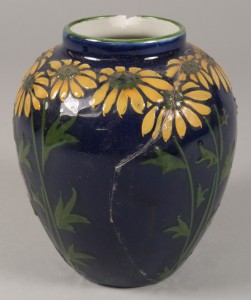How many times as a ceramics auctioneer have I seen a rare pot only to turn it over and with a long sigh say ‘Ah if only it wasn’t damaged’. The cynics amongst you probably believe it is a turn of phrase used to diminish expectation at auction when faced with some small fault; I can assure you it’s not.

A second series Urbato Ware vase for Wileman & Co (EX81)
People who work with pots tend to be passionate about them so whilst working on the Rhead Cronin Collection I have been genuinely saddened when I have come across a flawed pot. However, at least one is comforted that these casualties can still tell a story as despite being imperfect they were retained by the owner.

A Wedgwood pate sur pate decorated vase, is this by a young Frederick Rhead (EX81)
When faced with the Urbato Ware moon flask, designed by Frederick Rhead whilst at Wileman & Co, the desire to retain it is understandable, as although cracked it does ‘look’ perfect. There is also a Wedgwood vase painfully minus its neck, ‘Ah if only…’, that has pate sur pate panels on blue alternating with olive ground panels with stylised foliage. It raises the possibility that, although unsigned, this was made by Frederick circa 1877-87, why else would the family wish to retain it?

A naturalistic Woods Elers Ware vase by Frederick Rhead (EX81)
Next there is another flawed piece of Elers Ware, a Wood & Sons range, undoubtedly the work of Frederick Rhead. Traditionally Elers Ware pieces have been more Art Nouveau and spartan in their handling whilst this small vase has a far more busy and naturalistic scheme. Has anyone seen this style of decoration on Elers Ware before?

A marked Woods & Sons Formosa pattern vase and an unmarked pate sur pate vase (EX81)
However, what intrigues me the most is a critically damaged and unmarked vase. The shape obviously Woods & Sons and cannot be anything other than the work of Frederick Rhead. Shortly after starting with them he was engaged to improve their range of fancy wares, hence the emergence of the Elers and Trellis patterns, but his decorative urges led him to experiment with pate sur pate ‘at prices well within reach of the average man’ to quote Bernard Bumpus.

Detail of the lobster pattern vase for Woods by Frederick Rhead (EX81)
The early pate sur pate was really just tubelining in disguise, but looking at this vase he did use the pate sur pate technique and by the look of these rather sumptuous lobsters rather successfully too. I guess that it never really went into full production as it was too labour intensive and costly. Other examples do exist as in recent conversation with Peter Mason it seems he may have unearthed evidence of another example.









